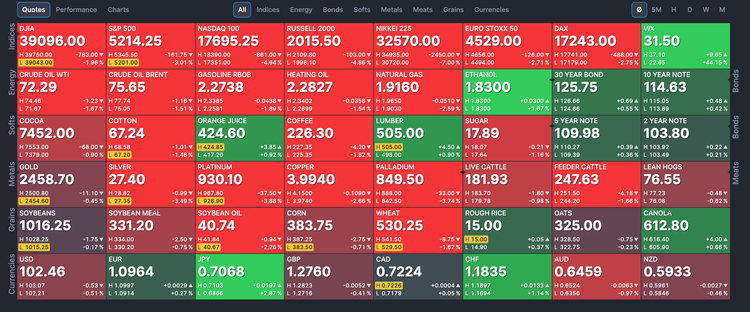Master the Art of Setting Stop Losses: Protect Your Trading Capital with Proven Strategies

Setting stop losses is a critical component of successful trading. This practice helps traders manage risk and protect their capital. However, choosing the right stop loss strategy can be complex due to the variety of methods available. I tend to use a combination of methods.
I'll explore the "art" of setting stop losses, focusing on the pros and cons of different strategies, including generic percentage stop losses, Average True Range (ATR) based stop losses, volatility-based stop losses, and other methods.
Understanding Stop Losses
A stop loss is an order placed with a broker to buy or sell once the stock reaches a certain price. It's designed to limit an investor's loss on a position in a security. While no trader likes to think about losing money, setting a stop loss is crucial for preserving trading capital and maintaining a disciplined trading approach.
Generic Percentage Stop Loss
A percentage stop loss involves setting a stop loss at a fixed percentage below (or above) the purchase price. For example, if you buy a stock at $100 and set a 10% stop loss, your stop loss would be at $90.
Pros:
- Simplicity: Easy to calculate and implement.
- Consistency: Provides a uniform approach to risk management across all trades.
- Discipline: Helps traders avoid emotional decision-making.
Cons:
- Market Conditions: Doesn't account for varying market conditions or volatility.
- Arbitrary: The chosen percentage may not reflect the actual risk of the trade.
- Overly Conservative or Aggressive: Depending on the percentage, it can either cut winners too early or give too much room to losers.
Average True Range (ATR) Based Stop Loss
The ATR is a volatility indicator that measures the degree of price movement for a given period. ATR-based stop losses set the stop at a multiple of the ATR, adapting to the stock's volatility.
Pros:
- Adaptive: Adjusts to the volatility of the security, providing a more dynamic stop loss.
- Informed Decisions: Bases the stop loss on statistical data rather than arbitrary percentages.
- Market Sensitivity: More likely to keep you in trades during normal price fluctuations.
Cons:
- Complexity: More difficult to calculate and requires continuous adjustment.
- Delayed Reactions: In highly volatile markets, the stop may be set too far, increasing potential losses.
- Subjectivity: Choosing the right multiple of the ATR can be subjective and varies by trader.
Volatility-Based Stop Loss
Volatility-based stop losses use indicators like Bollinger Bands or standard deviation to set stops based on the security's volatility. These stops are typically set outside normal price movements, reducing the chances of being stopped out by normal market noise.
Pros:
- Tailored: Customized to the security's price movements and volatility.
- Flexibility: Can be adjusted to fit different trading strategies and time frames.
- Noise Reduction: Less likely to be triggered by minor price fluctuations.
Cons:
- Indicator Reliance: Requires a good understanding of volatility indicators and their limitations.
- Complexity: More complex to set up and manage compared to percentage stops.
- Variable Risk: The risk level can vary significantly between different securities.
Other Stop Loss Methods
1. Time-Based Stop Loss: Closes the position after a predetermined time period, regardless of price movement.
Pros:
- Simple: Easy to implement and doesn't rely on price movements.
- Emotion-Free: Removes emotional decision-making from the process.
Cons:
- Arbitrary: May close out positions prematurely or too late, depending on market conditions.
- Risk of Loss: Doesn't account for significant price changes within the time frame.
2. Trailing Stop Loss: Moves with the price of the security, locking in profits as the price moves in your favor.
Pros:
- Profit Protection: Locks in profits while allowing the position to grow.
- Dynamic: Adjusts with the price movement, providing flexibility.
Cons:
- Whipsaw Risk: In volatile markets, trailing stops can be triggered prematurely.
- Management: Requires constant monitoring and adjustment.
3. Technical Indicator-Based Stop Loss: Uses indicators like moving averages or support/resistance levels to set stop losses.
Pros:
- Strategic: Based on technical analysis and key market levels.
- Informed Decisions: Uses data and chart patterns to inform stop loss placement.
Cons:
- Complexity: Requires a strong understanding of technical analysis.
- Subjectivity: Different traders may interpret indicators and chart patterns differently.
Conclusion
Choosing the right stop loss strategy is crucial for effective risk management in trading. While each method has its pros and cons, the key is to find a strategy that aligns with your trading style, risk tolerance, and market conditions.
Whether you opt for a simple percentage stop loss, an adaptive ATR-based stop, or a sophisticated volatility-based method, the goal remains the same: to protect your capital and enhance your trading discipline.
Get more with Premium







Member discussion